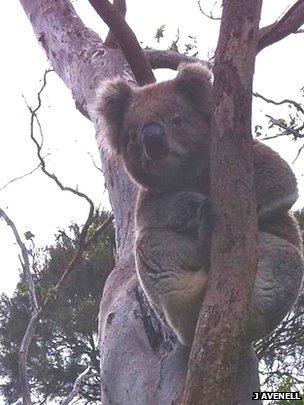Koalas bellow with unique voice organ
- Published
See a male koala making the extraordinary bellowing sounds (footage by Benjamin D Charlton at Lone Pine Koala Sanctuary, Brisbane)
It is a low, rumbling bellow that seems very incongruous coming from the mouth of a diminutive koala.
And now scientists have found that these famously sleepy marsupials have evolved a vocal organ that allows them to produce very low-pitched sound.
Koalas, researchers discovered, have an "extra pair of vocal folds" outside the larynx, which they use to make their mating calls.
The findings are published in the journal Current Biology, external.
"The first time I heard a koala bellow I was genuinely amazed that an animal this small could produce such a sound," said Benjamin D Charlton, of the University of Sussex, who led the research.
The pitch of the bellow, Dr Charlton said, was about "20 times lower than would be expected for an animal of its size".
"[It is] more typical of an animal the size of an elephant," he told BBC News.
The pitch of a call is generally associated with a mammal's size, because vocalisations come mainly from the larynx - an organ we sometimes refer to as our "voice box".
This organ has a valve-like opening with two lips - or folds - running across it. The vibration of these folds creates most of the sound we make when we speak.
Smaller mammals, like koalas, which can weigh as little as 8kg (18lb), tend to have a smaller larynx with shorter, thinner vocal folds. And just like strings on a musical instrument, these make a higher pitched sound.
But when the researchers dissected the koalas' vocal tracts, they found a second, larger set of vocal folds.
"[They] are located outside the larynx, where the oral and nasal cavities connect," said Dr Charlton.
These folds, called the velar vocal folds are "over three times longer and around 700 times heavier than the laryngeal vocal folds", he added.

Very low pitch might help koalas transmit information more clearly in their calls
"Larger structures can oscillate at lower frequencies.
"Just think of a guitar string - as you shorten the string by placing a finger on the fret board, you raise the frequency of the sound produced, and the thickest strings produce the lowest frequencies."
"Dr David Reby, from the University of Sussex, who was also involved in the research, explained that the animals' "unique vocal folds" were part of the soft palate, and "much bigger than the laryngeal vocal folds".
He said that humans created a similar effect when they snored, but added that our own soft palate was "not specialised for the production of sound".
The researchers think the very low pitched calls might have evolved, because it helped the koalas to transfer information more clearly in their vocalisations.
Dr Charlton added: "Another possibility is that low pitch acts as a direct cue [to females of the male's quality], but this remains a topic for future studies."